
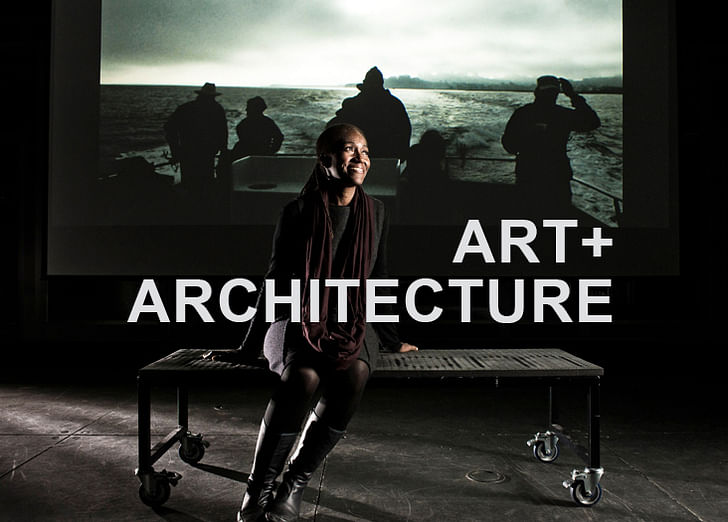
Where does an encounter with a work of architecture begin? There is the building as it first emerges on the horizon. Then the series of connected moments as you approach, that, like in a film, change according to variables of speed and distance, of the position of the subject in relation to the object. There is also the moment of crossing the threshold, the ambiguous line that demarcates inside from outside.
Even before all of this, there are the images and texts that precede the physical encounter, that already structure your view of the building before you arrive. There is also the whole concatenation of other historical architectures that are embedded as traces in any and every single building, waiting for some future archaeologist or translator to come and give them a voice. There are the whole worlds of thoughts, languages, images and objects in relation to one another that precede and surround the mere possibility of an encounter with any work of architecture. Finally, of course, there is also the question of the return, which inevitably reshapes and transforms the beginning.
There are the whole worlds of thoughts, languages, images and objects in relation to one another that precede and surround the mere possibility of an encounter with any work of architecture.
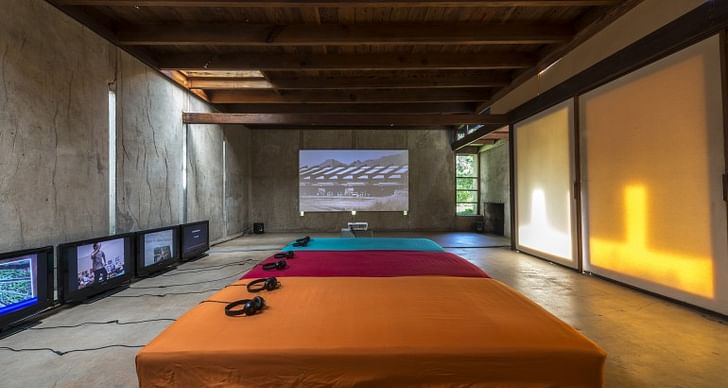
In her work, Renée Green explores these questions surrounding an encounter. She uses film, installations, archived material, writing and other media to investigate specific sites and attempts to give voice to their layered histories and surrounding contexts. Drawing complex webs of interaction, she makes visible otherwise hidden relations between people, objects, and places. Simultaneously, any expository quality to her work starts to withdraw at the moment as it appears. She allows the shadows and shrouds to remain, but turns them into material to be played with, intensified. Time is a recurrent element, although seemingly always out of joint.
Drawing complex webs of interaction, Renée Green makes visible otherwise hidden relations between people, objects, and places.
A professor at the School of Architecture and Planning at MIT, in its Program in Art, Culture and Technology (ACT), Green has a maintained interest in architecture and consistently involves buildings and sites in her studies. Her influential early work Code: Survey is permanently exhibited at the Caltrans District 7 Headquarters in Downtown LA as well as online, and was informed by the ideas behind the Morphosis building. The work is an edited, investigatory archive of the history of transportation in Los Angeles and the role it has played in the formation of the city. Green’s 1994 work Secret documents her experience living in Le Corbusier’s Unité d'Habitation in Firminy. Her film Elsewhere? considers imaginary places, gardens, and architectural follies.
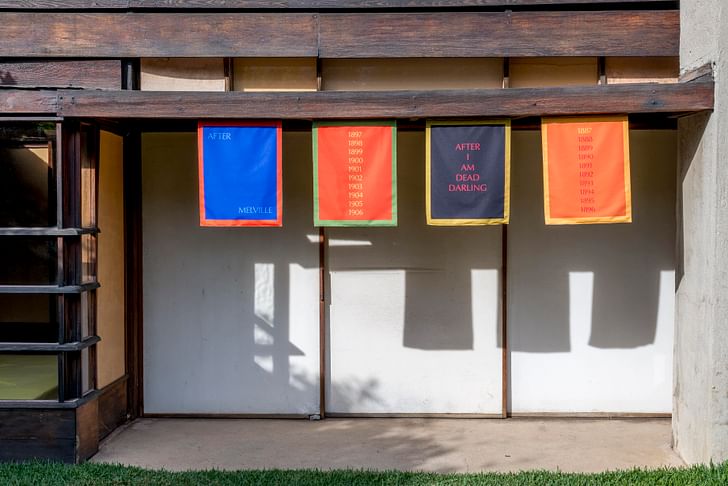
Stemming from a 2008 invitation to do a solo exhibition in the Schindler House at the MAK Center in West Hollywood, Begin Again, Begin Again, consists of a site-specific installation within the historic 1922 house and is currently on exhibit. It includes multiple sound installations, a series of banners printed with text and dates, vitrines with posters, videos, and her recently published book of selected writings, Other Planes of There, which one can find left open on a mattress on a floor. As the exhibit has been running, Green has continuously edited one of the videos on display. The completed film will be screened March 25th at 356 S. Mission Rd. in Los Angeles.
Every single work stretches on beyond temporal and physical containers, bleeding into one another but also into a greater context.
Begin Again, Begin Again is a complex, thought-provoking activation of the building and the ghosts that pervade it. Like with the rest of her projects, both the book and the exhibit are the result of years, even decades, of research, writing, and thinking. There is a sense of constant movement as she traces and retraces diverse, even apophenic, lines of connection. Her work is intertextual; she consistently “gives props” to the many figures who lurk in the shadows behind her objects of study. Perhaps a counterweight to contemporary obsessions with rapidity, Green’s work is stubbornly durational and patient: it seems that every single work stretches on beyond temporal and physical containers, bleeding into one another but also into a greater context.

Green and I corresponded over email about both Begin Again, Begin Again and her practice, more generally. “I’ve now had ample time to digest your questions. Yet I’ve been finding it difficult to answer your questions head on,” she wrote. “What I can do is interpret them in a way that allows me to answer them, perhaps more circuitously, as I’d like to convey my thoughts and intentions in a way I can recognize.” What follows is the text of our conversation, an “interpreted interview.”
I begin to trace intuitions, speculations, impulses, lines of interest and their intersections.
Your work tends to involve complex investigations of sites, objects, art works or other artifacts. How do you begin an engagement with a new object of examination?
I think that my circuitous approach in responding is related to the way I approach developing my work. The processes are nonlinear and emerge in different ways. My attention becomes drawn to what can surprise me, or shift my perception and my consciousness in some way. Sparks occur. I begin to trace intuitions, speculations, impulses, lines of interest and their intersections. What I’m describing is akin to what was referred to as an assemblage by both Deleuze and Guattari, a becoming, which makes any singular beginning, without its conditions of relation, impossible to isolate.
I would describe my approach as simultaneously probing and unraveling, while also opening myself up to not knowing, to going back and forth between imagining and questioning what I imagine I know. So locating a clear beginning is difficult as my engagement usually grows out of my interest in something particular – this can even be a feeling, a mood, or an ambiance, which may in turn be linked to something else. What a project allows or opens is an attraction. I follow that. Whatever it is. Even without having a clear idea. The further I delve into my curiosity by questioning – usually until I’m saturated with what I’ve collected, stimulated by what I wonder while wandering, as well as via more directed investigations – I’m able to eventually select and locate aspects that seem relevant to whatever it is I’m attempting to do. A project is an opportunity to imagine and come closer to something that matters in some way, to me and perhaps to others.
What relation could develop between the questions and the encounter with the house, the site, the remnants of previous times and observations in the present?
And when there is an invitation, as there was in this instance, what happens? If the invitation is compelling in relation to my interests, the above process may begin. In this case there were links to locations, both to the Schindler House, Los Angeles, and to Vienna. Often developing a work is related to ideas and feelings I’d like to further engage with, “unfinished business,” or aspects of my curiosity about life that I’d like to engage. Diving into what isn’t yet resolved. For myself, returning to thinking about Vienna, where I used to live and work, as well as California, where I also used to live and work, and LA, which I’d frequented and where I worked.
In much of my work I repeatedly return to ways of perceiving space, questions of site, including and exceeding questions usually posed by architecture. As I’m working in a school of architecture and planning, yet as an artist surrounded by architects and engineers, I often think about these things, now from different perspectives. Yet, I still had questions about Schindler, as well as about myself. It is impossible not to imbricate myself in a project, not in terms of an egotistical or autobiographical desire, but in terms of asking hard questions and facing what is, as well as [the] lacunae – what isn’t apparent. What can be felt. What relation could develop between the questions and the encounter with the house, the site, the remnants of previous times and observations in the present? These questions provided an impetus.
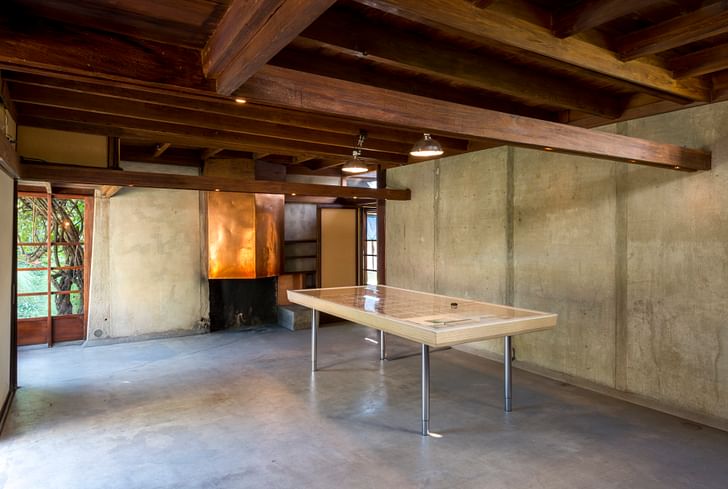
What about the traces of previous years and lives, and many “afters”?
The exhibition is entitled “Begin Again, Begin Again” – so there’s already a sort of tautology at play, seemingly implying a corruption of the beginning, or at least that the beginning is already a repetition. This seems to echo the repeated dates on banners and on the overlapping audio tracks that are scattered across the site. Still, there is a literal first year and a last year (the present year). What are the temporal boundaries you demarcated for this specific site and what zones or mechanism of permeability or slippage – to use one of your terms – serve as disruption?
In terms of thinking about the title, Begin Again, Begin Again, yes, repetition is at play, beginning being something that is returned to again and again. In addition repetition is used to simulate a wish, as a preliminary chant, indicating what is heard on an audio track upon entering the house. Was it Schindler’s wish? Many other peoples’ wishes, in America, California, LA—for example? Is this ever possible? How might it be possible? Or at least imagined, if not attempted and enacted? As you mentioned, there are echoes and overlaps, between the elements I used throughout the exhibition. What about the traces of previous years and lives, and many “afters”? What is heard on the audio tracks that permeate the house is a repetition enunciated in varying ways many times, as if uttering repeatedly could make a beginning occur.
Sitting outside at night I began imagining what the house and the garden could have been like when the house was built.
Rhythms are created visually and aurally. Elements also include intersecting parts that are not directly related to Schindler but that, as Trinh T. Minh-ha said, “speak nearby.” Considering relations between people and friendship between people, and also friendships with what is made by someone – what Deleuze might have referred to as an “encounter,” even making friends with earlier works, was also an element.
The years between the invitation until 2015 accumulated, as did projects, retrospective exhibitions, and perception and location shifts. In terms of “slippages” the permeability and disruption that you’ve wondered about took place in abundance. Many notebooks were filled since then. Some of what I developed is in the book, Other Planes of There. Yet, in time I hope to trace in more detail what your questions have sparked.
I can’t remember when I first visited the house. It blurs with my time in Vienna in relation to the MAK. Probably in the early 2000s, when I moved to California. Concerts in the garden. SASSAS, The Society for the Activation of Social Space through Art and Sound. Always calming and enjoyable, like a refuge-garden. Sitting outside at night I began imagining what the house and the garden could have been like when the house was built.

The Schindler House obviously has historic importance and has undergone extensive preservation efforts. On a practical level, how did you engage with the limitations of this?
I incorporated the constraints into my framework of the process I evolved. I used these as material. Schindler used space and I used the space and the constraints, house rules—an interesting irony and tension. Choices. Selected elements, in this instance. A certain lightness. Respecting the house, its space, and its beauty. Yet wondering about the house, the site, and the people who’d inhabited, as well as the site before it was designated as a site—in relation to what else? To be in conversation with these elements of wonder and to imagine. To play with the house and the site. To experience it in ways I hadn’t before. Physically. Perceptually. To lie on the floor. To hear sounds in it as I wanted to hear them.
Its about allowing and listening and feeling, rather than suppressing and repressing and claiming.
Your work involves an expanded temporality, an attempt to invoke ghosts and reveal traces that displace any immediate establishment of a present. So in a certain sense, your work is also preservational: it deals with survival. In Other Planes of There, a book released concurrently with the exhibition, you write: “Living architecture means an acceptance of ruin to come.” On a different level than the last question: how do you conceive of this project in relation to preserving? Is this specific house still a living architecture, even as it is put into the process of conservation?
“Expanded temporality,” yes. It’s part of the concept of the exhibition that I continue to test while finishing the film, Begin Again, Begin Again, which will augment the first stanza currently projected in the house, when it is completed. The present and what accompanies us is a prevalent theme circulating throughout the work and in the exhibition. Traces. As you say specters, ghosts. “Preservational” is a word you suggest in terms of my work as you mention it in relation to “survival.” I would rather describe it as enunciatory. Actually the work probes to find buried aspects, what hasn’t been wanted and to discover what else can be felt, thought, imagined—beyond what we think we know. First emergence and recognition would need to take place before preserving. Its about allowing and listening and feeling, rather than suppressing and repressing and claiming.
Architecture is an interesting example in repression, combined with preservation, yet decay is inevitable as well as returns of what’s been repressed, in different forms for example. This house. Life in relation to it is apparent. It is still surprising. What is possible to observe by encountering it in a full sense? What Schindler attempted, stated in his 1912 manifesto, was beautifully and profoundly achieved in this physical enactment of using space as a medium—the unexpected consequences don’t detract from this enacted wish, yet everything is always in relation to something, even what one is ignorant of. In this house-as-manifesto he also pays homage to his sources, physically if not verbally. California. The Pacific coast. Japan. Loos. Wright. His experiences in nature, whether in Styria or in Yellowstone.
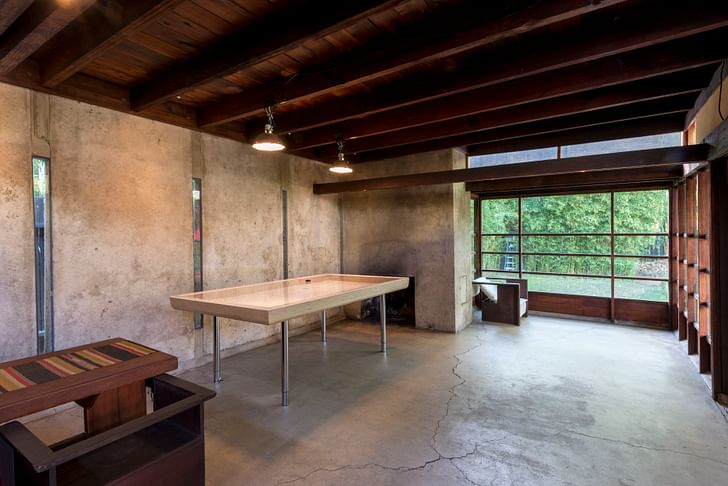
If there is any single specter that looms largest over “Begin Again, Begin Again,” it seems that it would be that of Rudolf Schindler, himself. Could you describe your relation to the architect and his work?
My relation to Schindler. It is actual in the encounters with his architecture and architecture he’d seen. My relationship with Vienna extends back to 1991, I inhabited Vienna, for five years (1997-2002) when I was a professor at the Academy of Fine Arts (Akademie der bildenden Künste, another name, but the same place), which he attended and I participated in architecture reviews at the Technical University, where he had attended before. It is imaginary in relation to how I imagine his existences in the times and spaces he traversed. The film provides an indication. Durational aspects of my engagement with the buildings, his past, my past and “exposition,” as you mention. What would be the “irreducibility of an object or a place,” especially as each encounter creates a particular evocation for a specific person? Leads to the next question, which I like, regarding balance. Watching light, change all day.
Things are in profound and complex relation. I’m interested in shifting attention to ways that these relations take place.
In Other Planes of There you write, “Coming closer and distanciation are linked.” In your work at the Schindler House, there is a palpable sense that as much as your work excavates, there is also a simultaneous withdrawal – that the object of investigation begins to recede as it comes into focus. Is this true? How do you balance exposition with something like doing justice to the irreducibility of an object or place, particularly in regards to the Schindler House?
I perhaps addressed your question in the circuitous course of my previous responses. We all bring our baggage. “Excavation” and “withdrawal.” Your terms, your experience. Interesting to ponder in addition to what I perceive and instigate: Space circulation, space creation, Space Poem. Closeness and distanciation. What I’ve mentioned and that you wonder about. These can be thought in relation to what happens with time, its shape, its confounding. For example, when someone is dying—what seems permeable (the effort to feel with the dying one), yet eludes, no matter how close you get to a body, the way a spirit or consciousness goes beyond it.
Balancing what your refer to as “exposition” with “doing justice to the irreducibility of an object or place” is at the crux of a challenge and difference I perceive between modes of engagement and approaches. Mine as an artist, doesn’t require me to expose in a documentary way, for example. When is justice ever done? To essay, as a verb, in the sense of to move through and to meditate on, as well as to invent and speculate in the forms I create is the best I can do. Things are in profound and complex relation. I’m interested in shifting attention to ways that these relations take place. I’m also involved with probing feelings that somatically manifest, in addition to processes of thinking. The Schindler House became a factor in an engagement of this process.
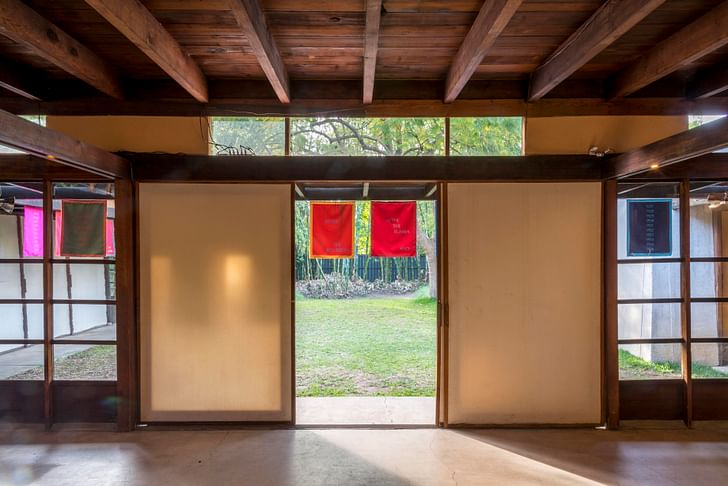
Home is a concept in relation to dwelling that is still being tested.
Finally, also in your book, you write, “Home is a slippery concept, whatever its discrete manifestation may be.” A home can be one place or many, tangible and/or immaterial. How do you conceive of the Schindler House as a home, in light of the radical reconsideration of dwelling in its initial design as well as today, as a Kunsthaus of sorts, and, finally, as the site of your current sojourn?
To conclude what I can now respond, I made an elliptical list, as I consider the Schindler House as a jumping off point for other and further imaginings, as well as explorations. I’m following up on your prompt about home. Home is a concept in relation to dwelling that is still being tested, as was attempted now nearly a century ago at in this house. Kunsthaus—the house is currently this, but still exceeds any traditional definition. The eccentricity of the house as object and place continues to evoke encounters. Sidney Bechet called the song a home. I think of a poem-home also. Space Poem. Other Planes of There-book-place. Beds. Félix Gónzalez-Torres. In the nursery. Imagining a child there. Books read: Going to Bed and Dreaming, Sleeping, Dying. Afters. Begin Again banner. Memento Mori. Threnody. Pleasure. Joy. Returns.
Writer and fake architect, among other feints. Principal at Adjustments Agency. Co-founder of Encyclopedia Inc. Get in touch: nicholas@archinect.com
No Comments
Block this user
Are you sure you want to block this user and hide all related comments throughout the site?
Archinect
This is your first comment on Archinect. Your comment will be visible once approved.